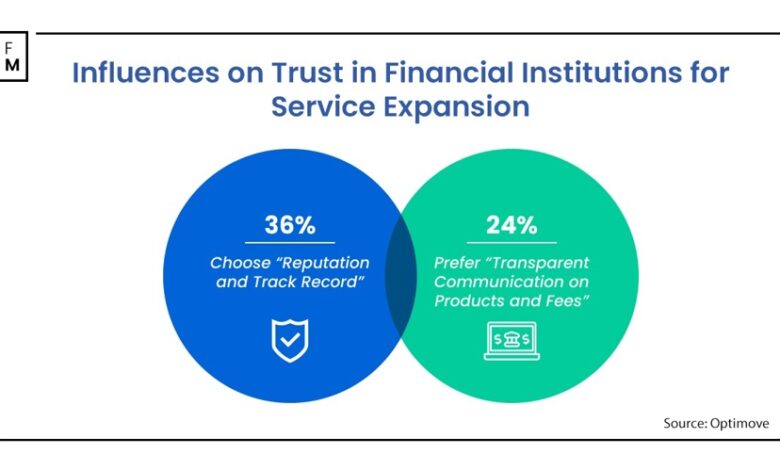“60% of Clients Don’t Trust Financial Institutions”: Fintech’s Customer-Centric Shift

In any business, especially
financial services, if you can get a customer to use more services, it reduces
churn. Of course, the starting point in financial services is that there is trust
between the provider and the client. With trust, a client can be open to other
services.
With that said, a research by Optimove revealed
that customers have limited trust in financial advisors for multiple financial
needs. The survey of 260 US customers of financial institutions with household
incomes of $100,000-plus, revealed that just 40% of clients of these firms
implicitly trust their financial institution as the primary financial advisor
for multiple financial needs.
It underscores that 60% of respondents do not “totally
trust” their financial service provider as their primary financial advisor for
multiple financial needs.
Retaining customers is harder. In
today’s dynamic financial landscape, characterized by evolving customer
expectations and rapid technological advancements, the banking sector faces
unprecedented challenges in retaining customers. As people prove to be
inherently unpredictable, navigating this uncertainty requires innovative
strategies tailored to the modern fintech landscape.
Human behavior is complex,
influenced by subjective, emotional, and context-dependent factors. Traditional
banking strategies, often reliant on rigid frameworks, struggle to adapt to
this unpredictability. As a result, customer churn rates
can rise, exacerbated by increased competition and regulatory constraints.
Financial service
companies are at the forefront of revolutionizing the banking industry,
leveraging innovative technologies and customer-centric approaches to address
the challenges of unpredictability and churn.
The Role of Data and Emotional
Intelligence in Fintech
Fintech firms are revolutionizing
customer experiences through the strategic utilization of data analytics and
artificial intelligence. By leveraging these technologies, they can delve deep
into individual customer preferences and behaviors, paving the way for
personalized interactions. Tailoring services to meet the unique needs of each
customer fosters stronger connections and cultivates loyalty, thus enhancing
the overall customer experience.
Real-time engagement lies at the
heart of effective customer communication for fintech companies. Embracing
channels like chatbots, mobile apps, and social media platforms
enables prompt and efficient interaction with customers. Timely assistance and
support not only build trust but also play a crucial role in mitigating churn,
ensuring sustained customer satisfaction.
The adoption of predictive
analytics empowers fintech firms to anticipate customer needs and offer
proactive solutions. By staying ahead of the curve, they enhance the customer
experience and nurture long-term relationships. Anticipatory services tailored
to individual preferences contribute significantly to customer satisfaction and
loyalty.
In addition to transactional
interactions, fintech companies are recognizing the importance of infusing
emotional intelligence into their communication strategies. Empathetic and
understanding communication resonates deeply with customers, strengthening their
emotional connection with the brand. This human touch adds depth to the
customer experience, fostering trust and loyalty in the long run.
Financial institutions are
increasingly integrating themselves into the lives of their customers by
harnessing the power of first-party data. For instance, Chase has launched
Chase Media Solutions, a digital
media business connecting millions of customers with brands they love.
Leveraging first-party financial data, this initiative enables personalized
offers and cashback opportunities for customers while providing tailored
experiences. This integration not only enhances customer engagement but also
forges stronger bonds between customers and the financial institution, creating
a win-win scenario for all parties involved.
Case Studies in Fintech Success
Numerous fintech firms have
already demonstrated the effectiveness of these strategies in improving
customer retention and reducing churn. Financial service companies have integrated
customer-led marketing platforms
as a cornerstone of their retention marketing , empowering these brands to
deliver personalized, emotionally intelligent communications in real-time. By
micro-segmenting customers based on predicted behavior and value, these
platforms enable financial marketers to maximize engagement and lifetime value.
Customer Retention Strategies
As the banking industry continues
to evolve, fintech companies must remain agile and adaptive in their approach
to customer retention. By embracing innovation, leveraging data-driven
insights, and prioritizing customer-centricity, they can navigate the complexities
of human behavior and emerge as leaders in the ever-changing financial
landscape.
While people may be
unpredictable, fintech companies possess the tools and strategies necessary to
enhance customer retention and mitigate churn in the banking sector. By
prioritizing personalized experiences, real-time engagement, predictive analytics, and
emotional intelligence, they can build stronger relationships with customers
and thrive in an era of rapid change. It all starts with the customer, knowing
their needs and wants. As financial
institutions have access to each customer’s first-party data, they start with a
leg-up on competitors in continually earning the customer’s business.
In the end, financial
institutions should focus marketing on their track record when looking to
cross-sell products. The aforementioned research
revealed: When asked about the factors that influence respondents’ level of
trust in their financial institution when considering purchasing additional
services, the top choice was “Reputation and track record,” selected by 36% of
respondents, followed by “transparent communication about products and fees”
noted by 24%.
In any business, especially
financial services, if you can get a customer to use more services, it reduces
churn. Of course, the starting point in financial services is that there is trust
between the provider and the client. With trust, a client can be open to other
services.
With that said, a research by Optimove revealed
that customers have limited trust in financial advisors for multiple financial
needs. The survey of 260 US customers of financial institutions with household
incomes of $100,000-plus, revealed that just 40% of clients of these firms
implicitly trust their financial institution as the primary financial advisor
for multiple financial needs.
It underscores that 60% of respondents do not “totally
trust” their financial service provider as their primary financial advisor for
multiple financial needs.
Retaining customers is harder. In
today’s dynamic financial landscape, characterized by evolving customer
expectations and rapid technological advancements, the banking sector faces
unprecedented challenges in retaining customers. As people prove to be
inherently unpredictable, navigating this uncertainty requires innovative
strategies tailored to the modern fintech landscape.
Human behavior is complex,
influenced by subjective, emotional, and context-dependent factors. Traditional
banking strategies, often reliant on rigid frameworks, struggle to adapt to
this unpredictability. As a result, customer churn rates
can rise, exacerbated by increased competition and regulatory constraints.
Financial service
companies are at the forefront of revolutionizing the banking industry,
leveraging innovative technologies and customer-centric approaches to address
the challenges of unpredictability and churn.
The Role of Data and Emotional
Intelligence in Fintech
Fintech firms are revolutionizing
customer experiences through the strategic utilization of data analytics and
artificial intelligence. By leveraging these technologies, they can delve deep
into individual customer preferences and behaviors, paving the way for
personalized interactions. Tailoring services to meet the unique needs of each
customer fosters stronger connections and cultivates loyalty, thus enhancing
the overall customer experience.
Real-time engagement lies at the
heart of effective customer communication for fintech companies. Embracing
channels like chatbots, mobile apps, and social media platforms
enables prompt and efficient interaction with customers. Timely assistance and
support not only build trust but also play a crucial role in mitigating churn,
ensuring sustained customer satisfaction.
The adoption of predictive
analytics empowers fintech firms to anticipate customer needs and offer
proactive solutions. By staying ahead of the curve, they enhance the customer
experience and nurture long-term relationships. Anticipatory services tailored
to individual preferences contribute significantly to customer satisfaction and
loyalty.
In addition to transactional
interactions, fintech companies are recognizing the importance of infusing
emotional intelligence into their communication strategies. Empathetic and
understanding communication resonates deeply with customers, strengthening their
emotional connection with the brand. This human touch adds depth to the
customer experience, fostering trust and loyalty in the long run.
Financial institutions are
increasingly integrating themselves into the lives of their customers by
harnessing the power of first-party data. For instance, Chase has launched
Chase Media Solutions, a digital
media business connecting millions of customers with brands they love.
Leveraging first-party financial data, this initiative enables personalized
offers and cashback opportunities for customers while providing tailored
experiences. This integration not only enhances customer engagement but also
forges stronger bonds between customers and the financial institution, creating
a win-win scenario for all parties involved.
Case Studies in Fintech Success
Numerous fintech firms have
already demonstrated the effectiveness of these strategies in improving
customer retention and reducing churn. Financial service companies have integrated
customer-led marketing platforms
as a cornerstone of their retention marketing , empowering these brands to
deliver personalized, emotionally intelligent communications in real-time. By
micro-segmenting customers based on predicted behavior and value, these
platforms enable financial marketers to maximize engagement and lifetime value.
Customer Retention Strategies
As the banking industry continues
to evolve, fintech companies must remain agile and adaptive in their approach
to customer retention. By embracing innovation, leveraging data-driven
insights, and prioritizing customer-centricity, they can navigate the complexities
of human behavior and emerge as leaders in the ever-changing financial
landscape.
While people may be
unpredictable, fintech companies possess the tools and strategies necessary to
enhance customer retention and mitigate churn in the banking sector. By
prioritizing personalized experiences, real-time engagement, predictive analytics, and
emotional intelligence, they can build stronger relationships with customers
and thrive in an era of rapid change. It all starts with the customer, knowing
their needs and wants. As financial
institutions have access to each customer’s first-party data, they start with a
leg-up on competitors in continually earning the customer’s business.
In the end, financial
institutions should focus marketing on their track record when looking to
cross-sell products. The aforementioned research
revealed: When asked about the factors that influence respondents’ level of
trust in their financial institution when considering purchasing additional
services, the top choice was “Reputation and track record,” selected by 36% of
respondents, followed by “transparent communication about products and fees”
noted by 24%.



